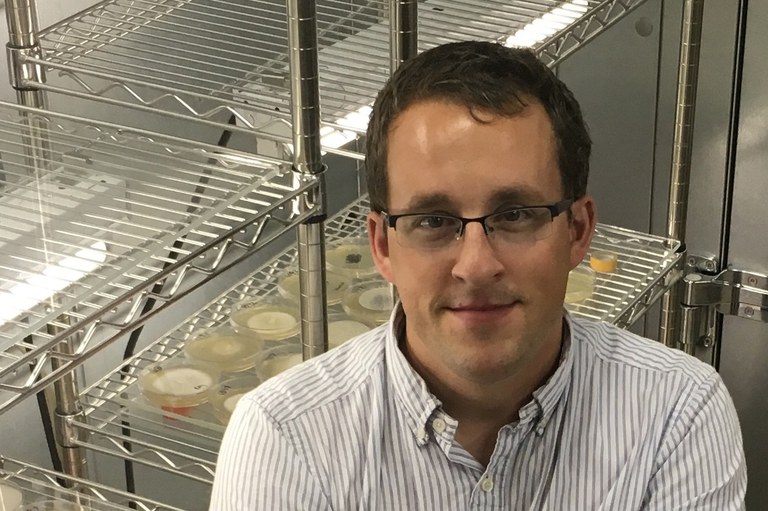Posted: May 22, 2017
Research tangent pursued in 2012 by inquisitive PhD student Matt Kasson provided starting point for international collaboration.
In 2012 then-Ph.D. candidate Matt Kasson (Ph.D., 2012), whose Ph.D. research focused on Verticillium wilt on invasive tree-of-heaven, became curious about wood-boring ambrosia beetles and their consistent presence in association with trees killed by the disease. Were they responsible for the spread of the Verticillium wilt pathogen?
As Kasson isolated fungi from beetles to see if they carried Verticillium, he also came across ambrosia fungi. Ambrosia beetles not only bore into dead trees, they inoculate the walls of the tunnels with an ambrosia fungi. The beetles lay their eggs in the tunnels, and the larvae feed on the fungi that grow. These beetles consistently carried a type of Fusarium, an unusual but previously-known ambrosia fungus.
When Kasson asked Dr. David Geiser for assistance in further study of the ambrosia beetle Fusarium, Geiser was not very encouraging. After all, there was no evidence that Fusarium had anything to do with the disease, and it was already known that some ambrosia beetles cultivate a Fusarium as a food source. But Kasson was persistent, and Geiser reluctantly assented. Since only a couple of Fusarium ambrosia beetle symbionts had been characterized using genetic characters, and both came from Asia, characterization of a new one would be publishable.
Neither Kasson nor Geiser could have foreseen how soon this research discovery would provide a starting point for understanding a new disease of avocado causing widespread damage in Israel and threatening production in California. In this new disease, invasive Euwallacea ambrosia beetles, which probably moved from Asia on wood-shipping materials, carried a Fusarium that not only fed ambrosia beetle larvae, but caused serious dieback of trees. In the Los Angeles Basin, the beetles quickly spread from a backyard avocado tree and approached the major avocado production areas to the east in Riverside County. In addition to the threat to the avocado crop, beetles invaded two major botanical gardens in the San Gabriel Valley, damaging over 100 tree species.
This crisis prompted an international gathering of avocado growers in 2012 in Riverside, CA, called "Invasive Ambrosia Beetle Conference: The Situation in California." There, it was revealed that similar ambrosia beetle/Fusarium problems afflicted trees in Florida, Asia, and Australia. Kasson and Geiser teamed with Dr. Kerry O'Donnell of the USDA/ARS, who put together an international team of researchers providing beetles and fungal material. Rather than having several labs around the world work independently, it was decided that a global team approach was needed to truly understand the diversity of these suddenly important fungi.
The result was a 2013 paper titled "An inordinate fondness for Fusarium: phylogenetic diversity of fusaria cultivated by ambrosia beetles in the genus Euwallacea on avocado and other plant hosts." Genetic characterization of the global collection revealed a single evolutionary lineage comprising nine unique Fusarium species lineages, for the most part associated with beetles from a single location. Further work showed that these lineages appear to be associated with unique beetle evolutionary lineages, and that both the fungi and the beetles may have hybridized. The paper's impact was timely (see Avocado farmers face unique foe in fungal-farming beetle), especially with more recent reports of riparian habitats in southern California that were destroyed by new beetles and new Fusarium. Four years later, the article ranks 10th in the top 25 most-cited Fungal Genetics and Biology articles.
Currently, Dr. Kasson is Assistant Professor of Forest Pathology at West Virginia University. His research continues to focus on fungi associated with arthropods and their roles in forest ecosystems, particularly diseases of trees, including the recently introduced beetle-borne Thousand Cankers Disease of black walnut.
Contact Information



